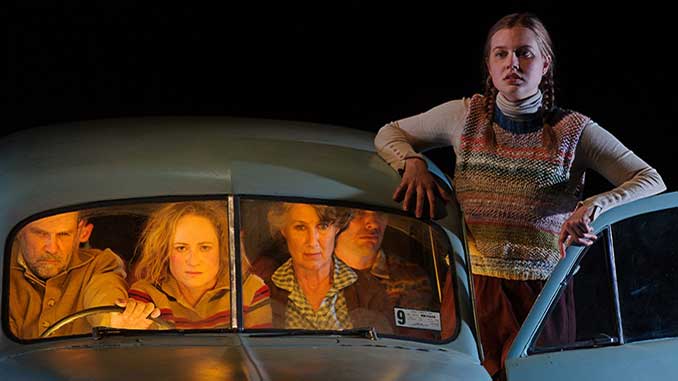 Patricia Cornelius is one of Australia’s most significant theatre voices. Her writing keeps audiences in a state of unease as it creates empathy with people who live on the edges of society.
Patricia Cornelius is one of Australia’s most significant theatre voices. Her writing keeps audiences in a state of unease as it creates empathy with people who live on the edges of society.
Her semi-autobiographical My Sister Jill is a story for us and about us and it’s so exciting to see it premiere on the Melbourne Theatre Company’s largest stage as part of the Next Stage writing program.
The title is an obvious riff on George Johnston’s 1964 semi-autobiographical novel My Brother Jack, which is about the Australian generations who survived and followed the Second World War.
Some of the most relevant and powerful Australian stories have been written about this time when the population was “booming” and Australian identity was being challenged as new generations questioned our cultural links to the rest of the world.
It was also a time when most of the population had witnessed wars, and their consequences, and kept trying to carry on as if everything was ok.
Everything was not ok.
Jack (Ian Bliss) was a POW in Asia. What he experienced is unimaginable. And it wasn’t talked about.
Today we have a better understanding of the uncontrollable impact of trauma and PTSD, but trauma and its impact on the next generations is still not talked about enough.
When Jack came home to the safe suburbs of Melbourne, he married Martha (Maude Davey) and they had five children (Jill – Lucy Golby, Johnnie – James O’Connell, twins Door and Mouse – Benjamin Nicol and Zachary Pidd, and Christine – Angourie Rice).
On the surface Jack is a good ol’ fun Aussie larrikin dad, but he is always moments away from violence and anger. Each member of his family deals with it differently, and as each character is given their own arc and story, we see how each are already holding Jack’s and their own trauma.
As Jack’s story is revealed, it’s easy to understand his behaviour but understanding doesn’t create sympathy. Bliss’s Jack struggles to change, but he can’t because he’s stuck in a time and place that he wants to forget and needs to understand, but he can’t do either.
As the story moves through the 1950s to the 1970s, his sons face conscription into the war in Vietnam and each member of the family finds their own way to escape. As each story is given its own space, each performer brings something personal to their characters and never lets their story dominate.
Cornelius writes about people who struggle and live with the fear of not being in control. Her characters often scare me; I don’t want to meet them IRL.
My Sister Jill isn’t like her Slut or Shit or Runt or Savages. These works are full of tension and fear because we know that the worst can, and probably will, happen. Cornelius often keeps us in a place of fear in her writing. However, while this work is about pain and trauma, it’s shaped with light and hope.
Much of the lightness, and comedy, is developed with director Susie Dee. Dee had worked with Cornelius for over 40 years and it’s hard to know where writing ends and direction begins when two creators have such trust in each other.
Dee’s crafting of the work is immaculate, from moving multiple characters around the set to create tipping points of balance to always puts story and character first.
Cornelius’s dialogue sounds naturalistic, but Dee ensures that its rhythm and rhyme catches you off-guard with its poetry. And, like poetry and music lyrics, it’s not what the characters are saying to each other, but what they are thinking. This brings us into their heads and lets us understand people whose behaviour scare us.
Her language makes us invest in the characters so much that it’s easy to miss how much the design and crafting is adding to our understanding and experience.
The design team have also worked with Cornelius and Dee before and each support the writing in ways that make it hard to imagine it being seen and heard in any other way.
Marg Horwell’s emotionally-dense designs are being seen a lot on MTC stages this year. This design is almost subtle compared to some of her others, but it’s intricate and complex.
A 1950s weatherboard house with cracking whitewash and a tile-patterned lino that doesn’t match the faded floral wallpaper (it’s not a Horwell design without flowers) sits next to an original re-furbished 1953 FX Holden.
As always, every costume and colour reveal so much about each character, especially as they age, and the set analyses the subtext of the script as walls move to let characters move in ways that make its naturalistic first impression fade.
And it’s lit by Rachel Burke. The lighting controls the mood and focuses attention exactly where it needs to be. It feels intimate while looking like a film, except for the shadows that could only be on a stage.
Which is all supported Kelly Ryall’s sound design that uses microphones that don’t sound like microphones and a score that quietly lets us feel the building tension and emotion.
My Sister Jill tells a familiar epic Australian generational story in a way that confronts and surprises with the kind of reflection that makes up question our own family memories. And the only way to see more great writing like this on our main stages is to keep commissioning, developing and supporting new Australian work.
My Sister Jill
Southbank Theatre – The Sumner, Southbank Boulevard, Southbank
Performance: Thursday 28 September 2023
Season continues to 28 October 2023
Information and Bookings: www.mtc.com.au
Image: Ian Bliss, Lucy Goleby, Maude Davey, James O’Connell and Angourie Rice in My Sister Jill – photo by Sarah Walker
Review: Anne-Marie Peard
